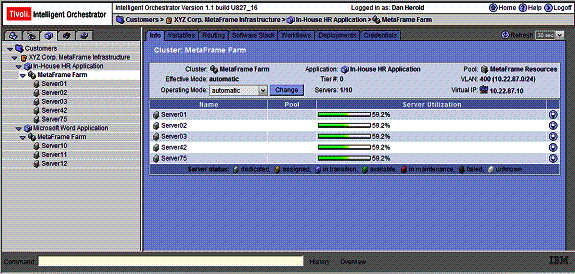| Tool Mentor: TIO - Supervise Tuning and Capacity Delivery |
 |
|
| Related Elements |
|---|
ContextTool mentors explain how a tool can perform tasks, which are part of ITUP processes and activities. The tasks are listed as Related Elements in the Relationships section. You can see the details of how processes and activities are supported by this tool mentor, by clicking the links next to the icons: DetailsThe IBM® Tivoli® Intelligent Orchestrator product includes all workflow automation functionality (and runs from the same development base) as the Tivoli Provisioning Manager product but with the addition of a "Data Acquisition Engine" component. The data acquisition engine enables Tivoli Intelligent Orchestrator the capability to draw metrics from managed target endpoints within the data center and react to those metrics based on a pre-determined Service Level policy. These metrics can be based on various instrumentation methods to determine load such as SNMP polling, integration to an existing monitoring system, or direct JMX calls. The Service Level policy decided the point at which the SLA metrics of a specific application are considered in a state of "probable breach ". Probability of breach is a metric that is calculated on a group of resources that serve the same purpose. For example, for a cluster of servers that are hosting a Web site while their metrics are measured independently of one another, the probability of breach is measured against the collective whole of the group to best determine the point at which point resource saturation (breach) will occur.
The analysis and response to these utilization gauges are customizable and are typically defined in accordance within the best practice policy of a given environment. Using the integrated workflow automation system, should the utilization of an application reach a critical threshold, Tivoli Intelligent Orchestrator can initiate the migration of an external resource (an additional server) to temporarily accommodate the increased load levels. As utilization levels stabilize, the resource is ultimately returned either to another application, or back into a "resource pool" that is available for deployment to other applications. Tivoli Intelligent Orchestrator is capable of repurposing servers based on their real-time utilization levels, but in addition, should an increased load be anticipated, a scheduling facility exists where an administrator can schedule additional resources at a specific time. A use case of this particular example would be in the case where an administrator wants to temporarily relocate servers during off-peak hours to assist other resources that are running nightly batch jobs. The scheduling functionality could be used to move non-essential hardware into the batch job application at a specific time (2:00AM for example), and return them to their primary duties at 6:00 AM , or anytime prior to the anticipated daytime load that is initiating. The number of applications that can be modeled in this way is unlimited. Coupled with the priority system, administrators are able to define the priority that each application has against the other. Should an application with a higher priority be in need of a temporary resource due to immediate demand, Orchestrator will examine each of the running applications that have a lower priority. Should any of these lower priority applications have an available resource, Tivoli Intelligent Orchestrator will temporarily reassign an overflow server from one of these applications to assist with the higher priority immediate need. Each cluster or application modeled within Tivoli Intelligent Orchestrator is defined within a given operating mode (Automatic, Semi-Automatic, or Manual). An Automatic state dictates that all resource requirements are handled automatically using data acquisition metrics and application priority levels. Semi-Automatic is similar to Automatic with the exception that all changes must first be approved by an administrator. Manual mode will only measure utilization and will suppress automatic reconfiguration recommendations. Using the built-in functionality that is provided by Tivoli Intelligent Orchestrator, monitoring and analysis of real-time application metrics are measured and responded to in accordance with corporate best practices and business needs. For More InformationFor more information about this tool, click on the link for this tool at the top of this page. |
©Copyright IBM Corp. 2005, 2008. All Rights Reserved. |
